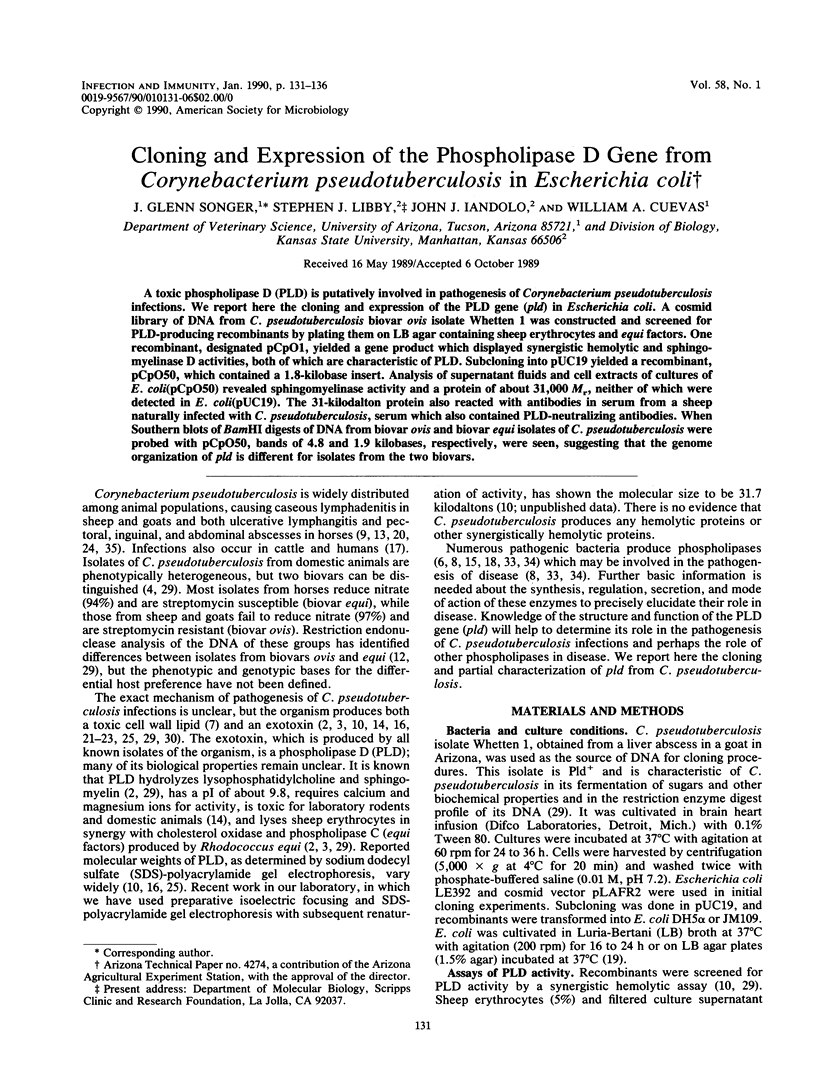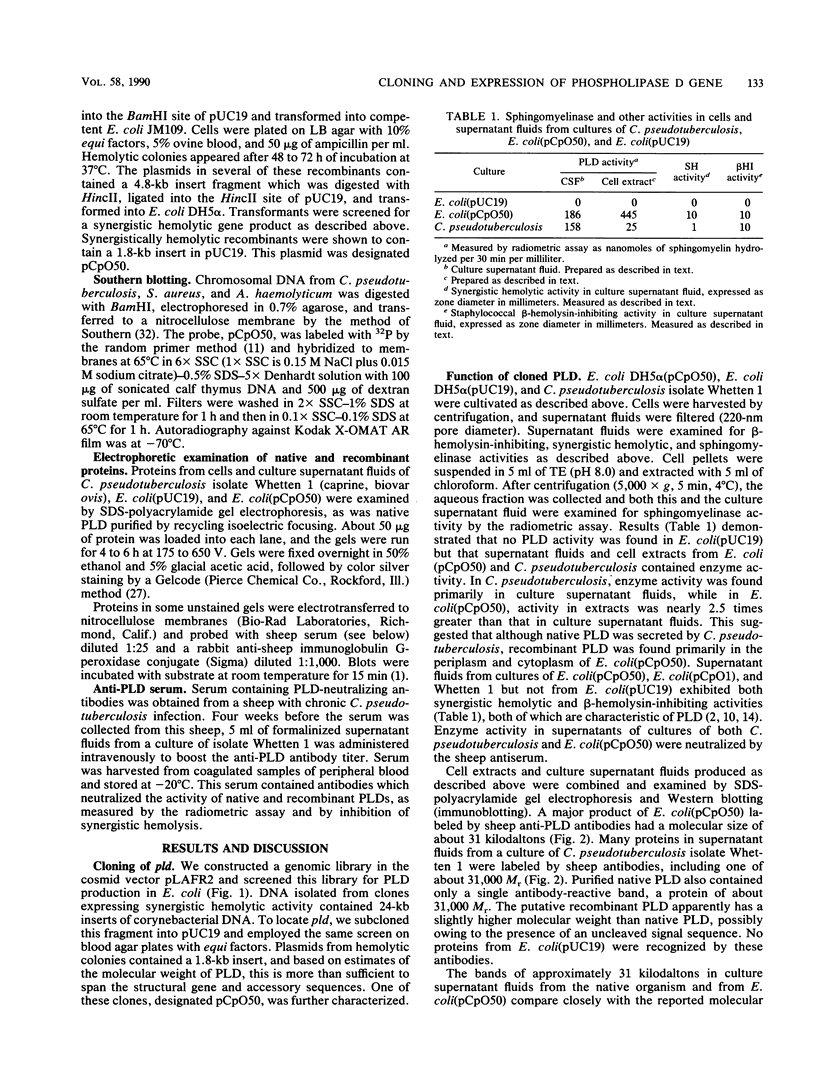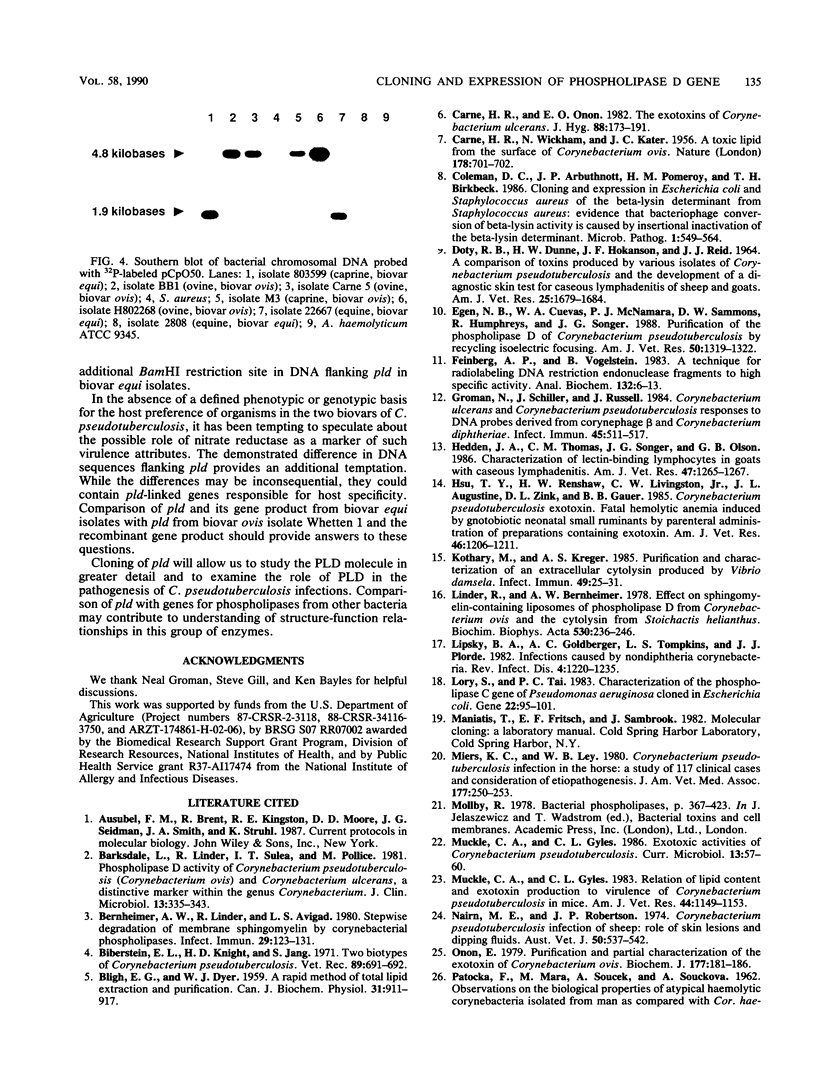Abstract
A toxic phospholipase D (PLD) is putatively involved in pathogenesis of Corynebacterium pseudotuberculosis infections. We report here the cloning and expression of the PLD gene (pld) in Escherichia coli. A cosmid library of DNA from C. pseudotuberculosis biovar ovis isolate Whetten 1 was constructed and screened for PLD-producing recombinants by plating them on LB agar containing sheep erythrocytes and equi factors. One recombinant, designated pCpO1, yielded a gene product which displayed synergistic hemolytic and sphingomyelinase D activities, both of which are characteristic of PLD. Subcloning into pUC19 yielded a recombinant, pCpO50, which contained a 1.8-kilobase insert. Analysis of supernatant fluids and cell extracts of cultures of E. coli(pCpO50) revealed sphingomyelinase activity and a protein of about 31,000 Mr, neither of which were detected in E. coli(pUC19). The 31-kilodalton protein also reacted with antibodies in serum from a sheep naturally infected with C. pseudotuberculosis, serum which also contained PLD-neutralizing antibodies. When Southern blots of BamHI digests of DNA from biovar ovis and biovar equi isolates of C. pseudotuberculosis were probed with pCpO50, bands of 4.8 and 1.9 kilobases, respectively, were seen, suggesting that the genome organization of pld is different for isolates from the two biovars.
Full text
PDF





Images in this article
Selected References
These references are in PubMed. This may not be the complete list of references from this article.
- BLIGH E. G., DYER W. J. A rapid method of total lipid extraction and purification. Can J Biochem Physiol. 1959 Aug;37(8):911–917. doi: 10.1139/o59-099. [DOI] [PubMed] [Google Scholar]
- Barksdale L., Linder R., Sulea I. T., Pollice M. Phospholipase D activity of Corynebacterium pseudotuberculosis (Corynebacterium ovis) and Corynebacterium ulcerans, a distinctive marker within the genus Corynebacterium. J Clin Microbiol. 1981 Feb;13(2):335–343. doi: 10.1128/jcm.13.2.335-343.1981. [DOI] [PMC free article] [PubMed] [Google Scholar]
- Bernheimer A. W., Linder R., Avigad L. S. Stepwise degradation of membrane sphingomyelin by corynebacterial phospholipases. Infect Immun. 1980 Jul;29(1):123–131. doi: 10.1128/iai.29.1.123-131.1980. [DOI] [PMC free article] [PubMed] [Google Scholar]
- Biberstein E. L., Knight H. D., Jang S. Two biotypes of Corynebacterium pseudotuberculosis. Vet Rec. 1971 Dec 25;89(26):691–692. doi: 10.1136/vr.89.26.691. [DOI] [PubMed] [Google Scholar]
- CARNE H. R., KATER J. C., WICKHAM N. A toxic lipid from the surface of Corynebacterium ovis. Nature. 1956 Sep 29;178(4535):701–702. doi: 10.1038/178701a0. [DOI] [PubMed] [Google Scholar]
- Carne H. R., Onon E. O. The exotoxins of Corynebacterium ulcerans. J Hyg (Lond) 1982 Apr;88(2):173–191. doi: 10.1017/s0022172400070054. [DOI] [PMC free article] [PubMed] [Google Scholar]
- Coleman D. C., Arbuthnott J. P., Pomeroy H. M., Birkbeck T. H. Cloning and expression in Escherichia coli and Staphylococcus aureus of the beta-lysin determinant from Staphylococcus aureus: evidence that bacteriophage conversion of beta-lysin activity is caused by insertional inactivation of the beta-lysin determinant. Microb Pathog. 1986 Dec;1(6):549–564. doi: 10.1016/0882-4010(86)90040-9. [DOI] [PubMed] [Google Scholar]
- DOTY R. B., DUNNE H. W., HOKANSON J. F., REID J. J. A COMPARISON OF TOXINS PRODUCED BY VARIOUS ISOLATES OF CORYNEBACTERIUM PSEUDOTUBERCULOSIS AND THE DEVELOPMENT OF A DIAGNOSTIC SKIN TEST FOR CASEOUS LYMPHADENITIS OF SHEEP AND GOATS. Am J Vet Res. 1964 Nov;25:1679–1685. [PubMed] [Google Scholar]
- Egen N. B., Cuevas W. A., McNamara P. J., Sammons D. W., Humphreys R., Songer J. G. Purification of the phospholipase D of Corynebacterium pseudotuberculosis by recycling isoelectric focusing. Am J Vet Res. 1989 Aug;50(8):1319–1322. [PubMed] [Google Scholar]
- Feinberg A. P., Vogelstein B. A technique for radiolabeling DNA restriction endonuclease fragments to high specific activity. Anal Biochem. 1983 Jul 1;132(1):6–13. doi: 10.1016/0003-2697(83)90418-9. [DOI] [PubMed] [Google Scholar]
- Groman N., Schiller J., Russell J. Corynebacterium ulcerans and Corynebacterium pseudotuberculosis responses to DNA probes derived from corynephage beta and Corynebacterium diphtheriae. Infect Immun. 1984 Aug;45(2):511–517. doi: 10.1128/iai.45.2.511-517.1984. [DOI] [PMC free article] [PubMed] [Google Scholar]
- Hedden J. A., Thomas C. M., Songer J. G., Olson G. B. Characterization of lectin-binding lymphocytes in goats with caseous lymphadenitis. Am J Vet Res. 1986 Jun;47(6):1265–1267. [PubMed] [Google Scholar]
- Hsu T. Y., Renshaw H. W., Livingston C. W., Jr, Augustine J. L., Zink D. L., Gauer B. B. Corynebacterium pseudotuberculosis exotoxin: fatal hemolytic anemia induced in gnotobiotic neonatal small ruminants by parenteral administration of preparations containing exotoxin. Am J Vet Res. 1985 May;46(5):1206–1211. [PubMed] [Google Scholar]
- Kothary M. H., Kreger A. S. Purification and characterization of an extracellular cytolysin produced by Vibrio damsela. Infect Immun. 1985 Jul;49(1):25–31. doi: 10.1128/iai.49.1.25-31.1985. [DOI] [PMC free article] [PubMed] [Google Scholar]
- Linder R., Bernheimer A. W. Effect on sphingomyelin-containing liposomes of phospholipase D from Corynebacterium ovis and the cytolysin from Stoichactis helianthus. Biochim Biophys Acta. 1978 Aug 25;530(2):236–246. doi: 10.1016/0005-2760(78)90009-7. [DOI] [PubMed] [Google Scholar]
- Lipsky B. A., Goldberger A. C., Tompkins L. S., Plorde J. J. Infections caused by nondiphtheria corynebacteria. Rev Infect Dis. 1982 Nov-Dec;4(6):1220–1235. doi: 10.1093/clinids/4.6.1220. [DOI] [PubMed] [Google Scholar]
- Lory S., Tai P. C. Characterization of the phospholipase C gene of Pseudomonas aeruginosa cloned in Escherichia coli. Gene. 1983 Apr;22(1):95–101. doi: 10.1016/0378-1119(83)90068-9. [DOI] [PubMed] [Google Scholar]
- Miers K. C., Ley W. B. Corynebacterium pseudotuberculosis infection in the horse: study of 117 clinical cases and consideration of etiopathogenesis. J Am Vet Med Assoc. 1980 Aug 1;177(3):250–253. [PubMed] [Google Scholar]
- Muckle C. A., Gyles C. L. Relation of lipid content and exotoxin production to virulence of Corynebacterium pseudotuberculosis in mice. Am J Vet Res. 1983 Jun;44(6):1149–1153. [PubMed] [Google Scholar]
- Nairn M. E., Robertson J. P. Corynebacterium pseudotuberculosis infection of sheep: role of skin lesions and dipping fluids. Aust Vet J. 1974 Dec;50(12):537–542. doi: 10.1111/j.1751-0813.1974.tb14072.x. [DOI] [PubMed] [Google Scholar]
- Onon E. O. Purification and partial characterization of the exotoxin of Corynebacterium ovis. Biochem J. 1979 Jan 1;177(1):181–186. doi: 10.1042/bj1770181. [DOI] [PMC free article] [PubMed] [Google Scholar]
- Songer J. G., Beckenbach K., Marshall M. M., Olson G. B., Kelley L. Biochemical and genetic characterization of Corynebacterium pseudotuberculosis. Am J Vet Res. 1988 Feb;49(2):223–226. [PubMed] [Google Scholar]
- Soucek A., Michalec C., Soucková A. Identification and characterization of a new enzyme of the group "phospholipase D" isolated from Corynebacterium ovis. Biochim Biophys Acta. 1971 Jan 13;227(1):116–128. doi: 10.1016/0005-2744(71)90173-2. [DOI] [PubMed] [Google Scholar]
- Soucek A., Soucková A. Toxicity of bacterial sphingomyelinases D. J Hyg Epidemiol Microbiol Immunol. 1974;18(3):327–335. [PubMed] [Google Scholar]
- Southern E. M. Detection of specific sequences among DNA fragments separated by gel electrophoresis. J Mol Biol. 1975 Nov 5;98(3):503–517. doi: 10.1016/s0022-2836(75)80083-0. [DOI] [PubMed] [Google Scholar]
- Titball R. W., Hunter S. E., Martin K. L., Morris B. C., Shuttleworth A. D., Rubidge T., Anderson D. W., Kelly D. C. Molecular cloning and nucleotide sequence of the alpha-toxin (phospholipase C) of Clostridium perfringens. Infect Immun. 1989 Feb;57(2):367–376. doi: 10.1128/iai.57.2.367-376.1989. [DOI] [PMC free article] [PubMed] [Google Scholar]
- Tso J. Y., Siebel C. Cloning and expression of the phospholipase C gene from Clostridium perfringens and Clostridium bifermentans. Infect Immun. 1989 Feb;57(2):468–476. doi: 10.1128/iai.57.2.468-476.1989. [DOI] [PMC free article] [PubMed] [Google Scholar]
- Williamson P., Nairn M. E. Lesions caused by Corynebacterium pseudotuberculosis in the scrotum of rams. Aust Vet J. 1980 Oct;56(10):496–498. doi: 10.1111/j.1751-0813.1980.tb02565.x. [DOI] [PubMed] [Google Scholar]




